Overnight, Refrigerator Focaccia = The Best Focaccia Bread Recipe
This post may contain affiliate links. Please read my disclosure policy.
Cold, refrigerated dough is the secret to making delicious focaccia! Allowing the dough to rest 18 to 48 hours in the fridge will yield extra-pillowy and airy focaccia, though if you are pressed for time, you can make this start-to-finish in 3 hours. This 4-ingredient recipe requires only 5 minutes of hands-on time. Video guidance below!
⭐️⭐️⭐️⭐️⭐️ Review:
“Love this recipe! I’ve made this so many times that I’ve lost count. Super simple and delicious. My family loves it. Whenever someone asks me for a focaccia recipe, I always show them this one. This recipe is awesome. Thank you for sharing!” — Lucy
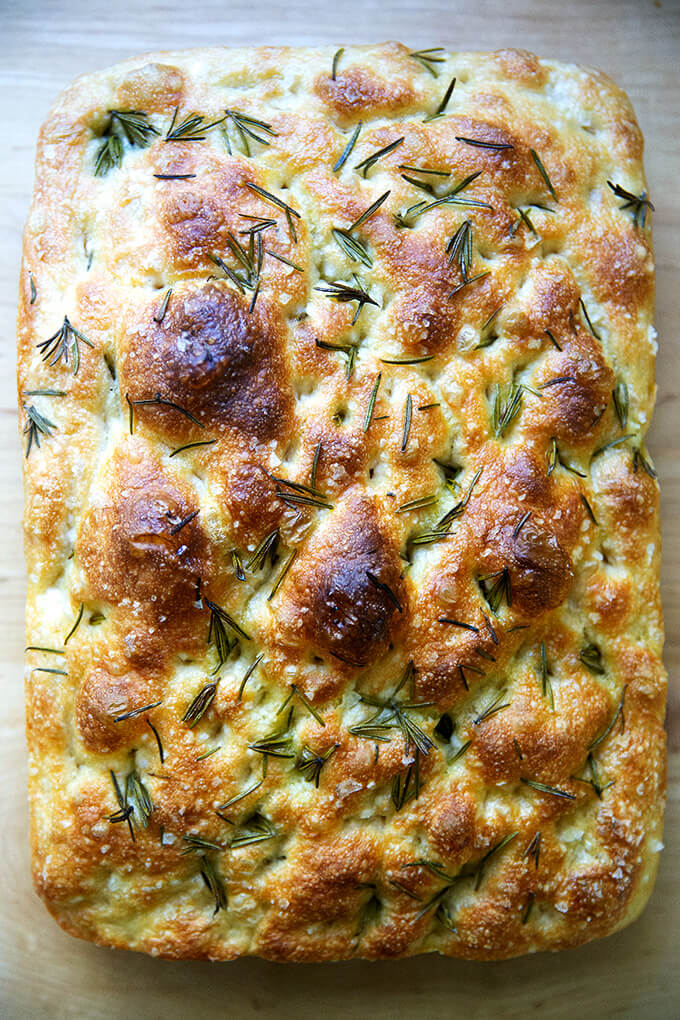
I’ve said it before and I’ll say it again: focaccia is the bread recipe for beginners. Why? Because:
- The no-knead, 4-ingredient dough takes 5 minutes to mix together.
- It requires no special equipment, no tricky shaping technique, and no scoring.
- If you have a 9×13-inch baking pan and your fingertips (for dimpling), you’re good to go.
- It emerges soft and pillowy, olive oil-crusted, golden all around, and it’s completely irresistible.
In sum, it’s hard to beat focaccia (pronounced foh-kah-chuh) in the effort-to-reward category. If you are intimidated by bread baking, this is the recipe I suggest making first, both for its simplicity and flavor. After all, this focaccia bread recipe is adapted from my mother’s simple peasant bread recipe, a recipe that has removed the fear of the bread baking process for many.
For the past few months, I’ve been making the focaccia bread recipe from my cookbook Bread Toast Crumbs, but changing the method: using more yeast, using less yeast, doing longer, slower rises at room temperature, doing longer, slower rises in the refrigerator. Find the results below.
This post is organized as follows:
- What Makes The Best Focaccia
- Four Tips for Success
- How This Focaccia Recipe Differs from Others
- Focaccia Bread Ingredients
- How to Make Focaccia, Step by Step
- Adding Rosemary, Herbs and Other Toppings to your Focaccia Dough
- How to Make a Focaccia Bread Art
- Tomato Focaccia
- How to Make a Focaccia Bread Sandwich
- Can I Skip the Overnight Rise?
PS: Once you master this simple focaccia, try your hand at this simple sourdough bread recipe, another recipe that requires minimal effort but yields spectacular results.

What Makes The Best Focaccia?
I’ll spare you all the details of the various experiments and skip straight to what I’ve found creates the best focaccia, one that emerges golden all around, looking like a brain, its surface woven with a winding labyrinth of deep crevices: high-hydration, refrigerated dough.
This is nothing novel—many bakers extol the virtues of the cold fermentation process—and it came as no surprise to me either: it was, after all, past-prime Jim Lahey refrigerated dough that showed me how easy focaccia could be: place cold, several-days-old pizza dough in a well-oiled pan, let it rise for several hours or until it doubles, drizzle with more oil, dimple with your fingers, sprinkle with sea salt, then bake until done.
Employing a refrigerator rise requires more time because the cold environment slows everything down initially, and during the second rise, the cold dough takes time to warm to room temperature. The overall effort, however, is very hands-off, and the result — a light, airy, pillowy dough — is well worth it.
As important as refrigerating the dough is using a high hydration dough, meaning a dough with a high proportion of water relative to the flour. The high proportion of water will create a dough with beautiful air pockets throughout. (Incidentally, this is the secret to making excellent pizza dough as well as light, airy sourdough sandwich bread.)
How This Focaccia Recipe Differs from Others
There are lots of focaccia bread recipes out there, so why make this one? This one differs from many of the recipes out there in two ways:
- The long, cold, refrigerator rise.
- The absence of sugar or honey or any sort of sweetener.
Why isn’t there any sweetener in this recipe? Simply stated, a sweetener is just not needed — the yeast, contrary to popular belief, does not need sugar to activate or thrive. Sugar will speed things up, but when you’re employing a long, slow rise, speed is not the name of the game.
Moreover, and this is getting a little scientific, but during the long, cold fermentation: enzymes in both the flour and the yeast will break down the starches in the flour into simple sugars, which will contribute both to flavor and to browning, again rendering sugar unnecessary. Cool, right?
Four Tips for Success
- Allowing the dough to rest 18 to 24 hours in the fridge yields the best results. (You can leave the dough in the fridge for as long as 72 hours.)
- A buttered or parchment-lined pan in addition to the olive oil will prevent sticking. When I use Pyrex or other glass pans, butter plus oil is essential to prevent sticking. When I use my 9×13-inch USA Pan, I can get away with using olive oil alone.
- Count on 2 to 4 hours for the second rise. This will depend on the temperature of your kitchen and the time of year.
- After the second rise, dimple the dough, then immediately stick the pans in the oven — this has been a critical difference for me in terms of keeping those desirable crevices. If you dimple and let the dough rise again even for 20 minutes before popping the pan in the oven, the crevices begin to dissolve.
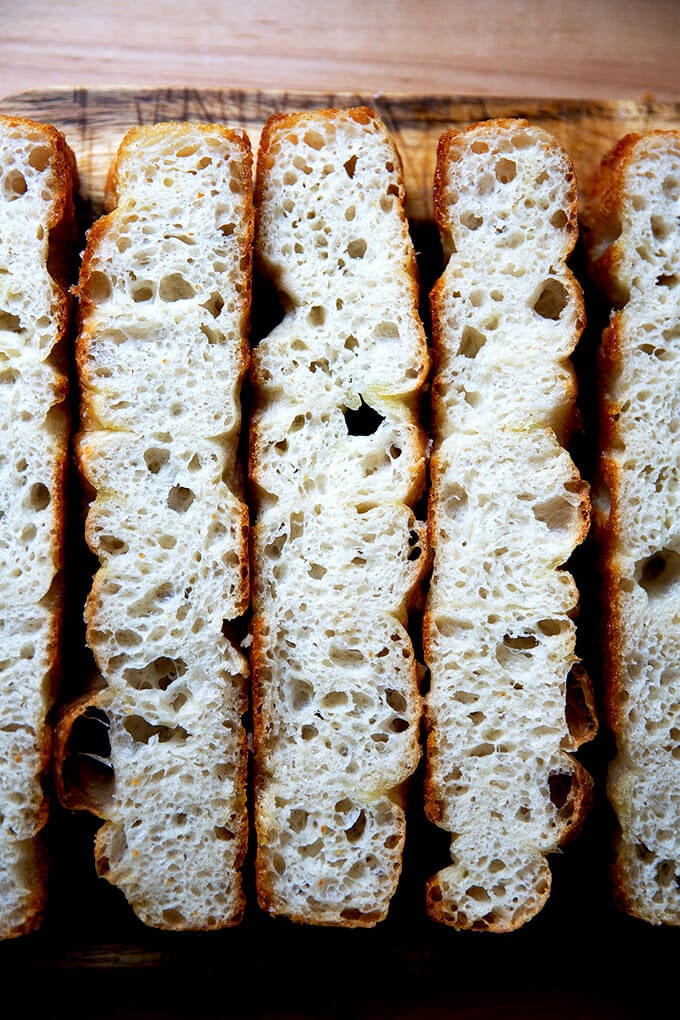
Ingredients
- Flour: bread flour or all-purpose flour will work equally well here. If you live in a humid environment or abroad, I suggest trying to get your hands on bread flour. King Arthur Flour is my preference.
- Yeast: SAF Instant Yeast is my preference, but active dry yeast works just as well. See recipe box for instructions on how to use active-dry yeast in place of instant.
- Salt: I say this all the time, but a big part of making a good loaf of bread comes down simply to using the right amount of salt given the amount of flour you are using by weight. It’s like anything: bread has to be well seasoned. At a minimum, use 10 grams (2 teaspoons) of salt for every 500 grams (4 cups) of flour. I highly recommend investing in some good, flaky sea salt for sprinkling on top of the focaccia dough — it tastes better than the more finely ground varieties of salt. I use Diamond Crystal kosher salt for the dough, but any salt you have on hand will work just fine for the dough.
- Water: There is a lot of water in this dough — it’s 88% hydration — and all of that water helps produce a light, airy, pillowy dough.
- Olive oil: Olive oil both in the bottom of the pan and on top of the dough is essential for encouraging nice browning, flavor, and that quintessential oiliness we all love about focaccia.
- Rosemary or other seasonings: Rosemary is a classic focaccia topping, and you can either sprinkle it over the dough before baking or you can chop it up and add it to the dough. Many people love sun-dried tomatoes and olives in their focaccia. See below for how to incorporate these other ingredients into your focaccia dough.
How to Make Focaccia Bread, Step by Step
Gather your ingredients: 4 cups (512 g) flour, 2 teaspoons (10 g) salt, 2 teaspoons (8 g) instant yeast (SAF is my preference), 2 cups (455 g) water:
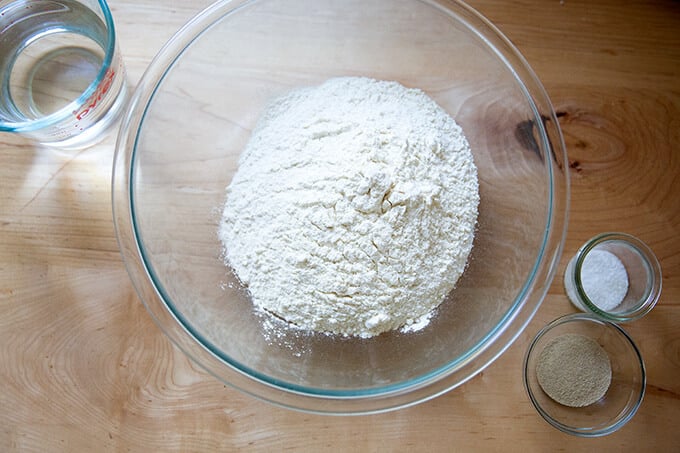
Whisk together the flour, salt, and yeast first:
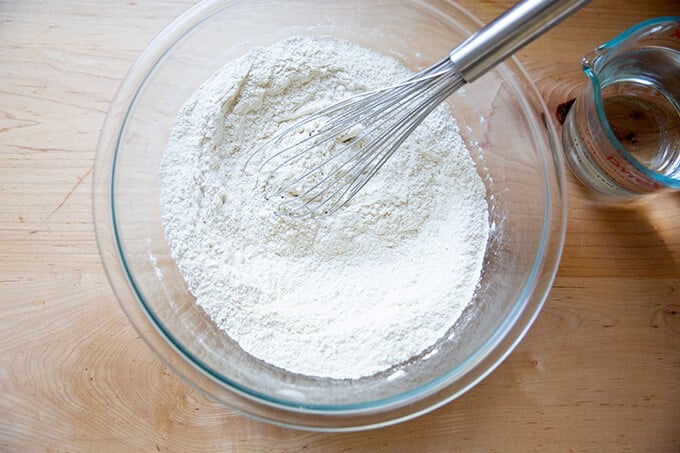
Add the water:
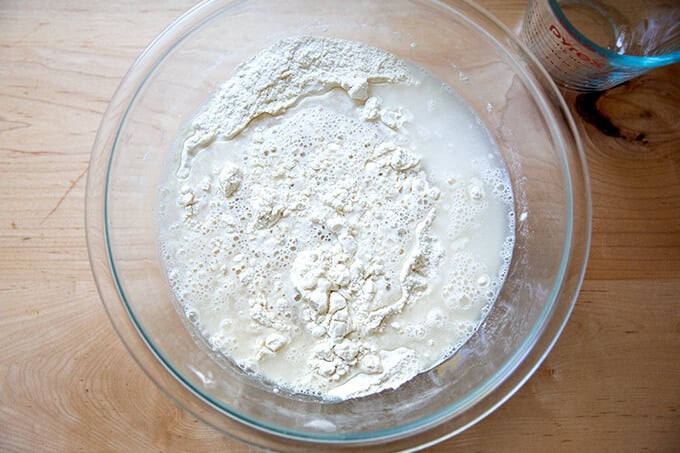
Use a spatula to stir the two together.

Slick the dough with olive oil:
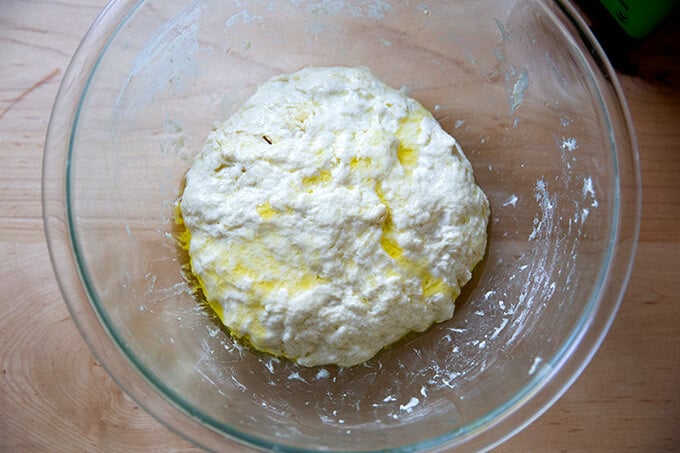
Slick the surface of the dough with olive oil; then cover the bowl. You all have one of these, right? Stick the bowl in the fridge immediately; leave it there to rise for 12 to 18 hours (or longer—I’ve left it there for as long as three days). NOTE: It is important the dough really be slicked with olive oil especially if you are using a cloth bowl cover or tea towel as opposed to plastic wrap or the lid pictured in the photo below this one. If you are using a tea towel, consider securing it with a rubber band to make a more airtight cover. If you do not slick the dough with enough oil, you risk the dough drying out and forming a crust over the top layer.
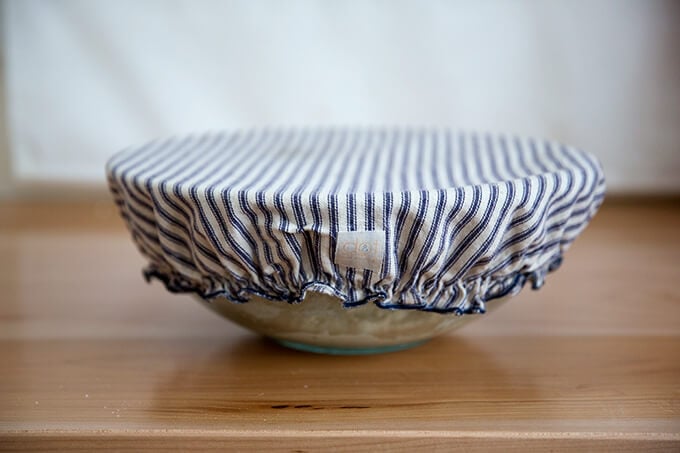
Another option: the lid that comes with the 4-Qt Pyrex bowl. This is handy for fridge storage because you can stack things on top of it.

Remove from fridge, and remove the cover:
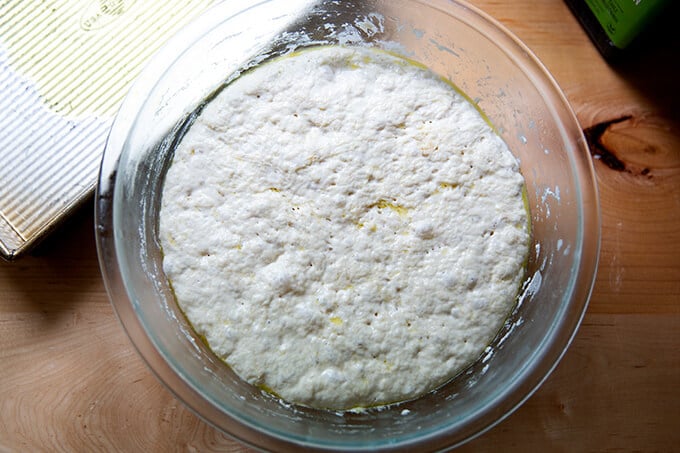
Deflate the dough and transfer to a prepared pan. I love this 9×13-inch USA pan. If you don’t have one you can use two 8- or 9-inch pie plates or something similar. If you are using glass baking dishes be sure to grease the dishes with butter before pouring a tablespoon of olive oil into each. (The butter will ensure the bread doesn’t stick.) Don’t touch the dough again for 2 to 4 hours depending on your environment.

After two to four hours, or when the dough looks like this…:

… it’s time to dimple it! You can use simply olive oil and salt — I recommend good, flaky sea salt for this. Note, the dough in the photo below spent three days in the fridge, and the dough was super bubbly!
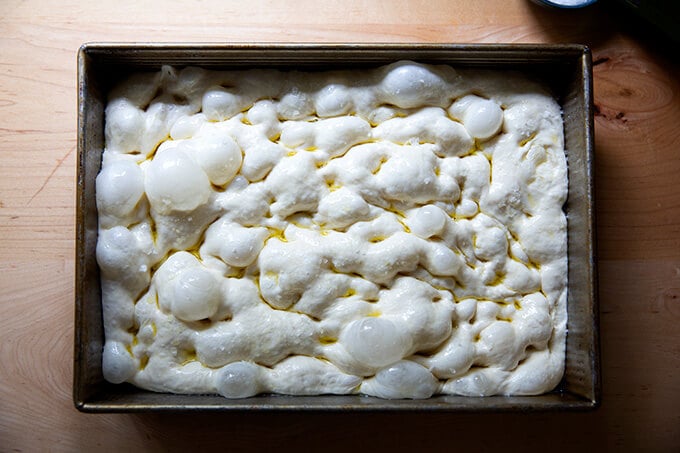
if you are using rosemary, sprinkle it over the dough. Then pour two tablespoons of olive oil over the dough, and using your fingers, press straight down to create deep dimples. Sprinkle with flaky sea salt — again, something like Maldon is great here.

Transfer to oven immediately and bake at 425ºF for 25 minutes or until golden all around. Remove focaccia from pans and place on cooling racks.
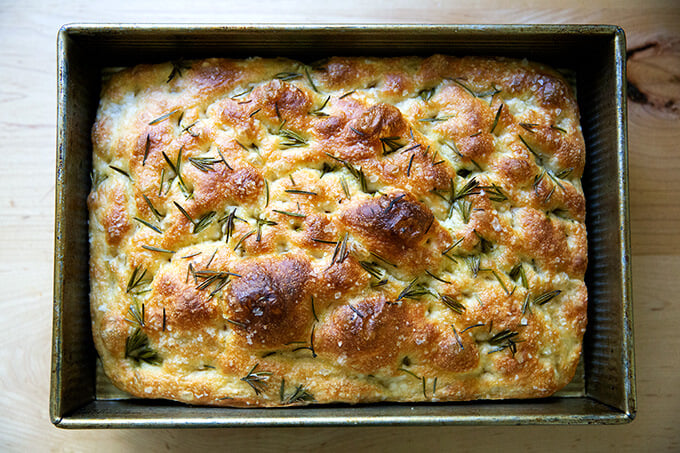

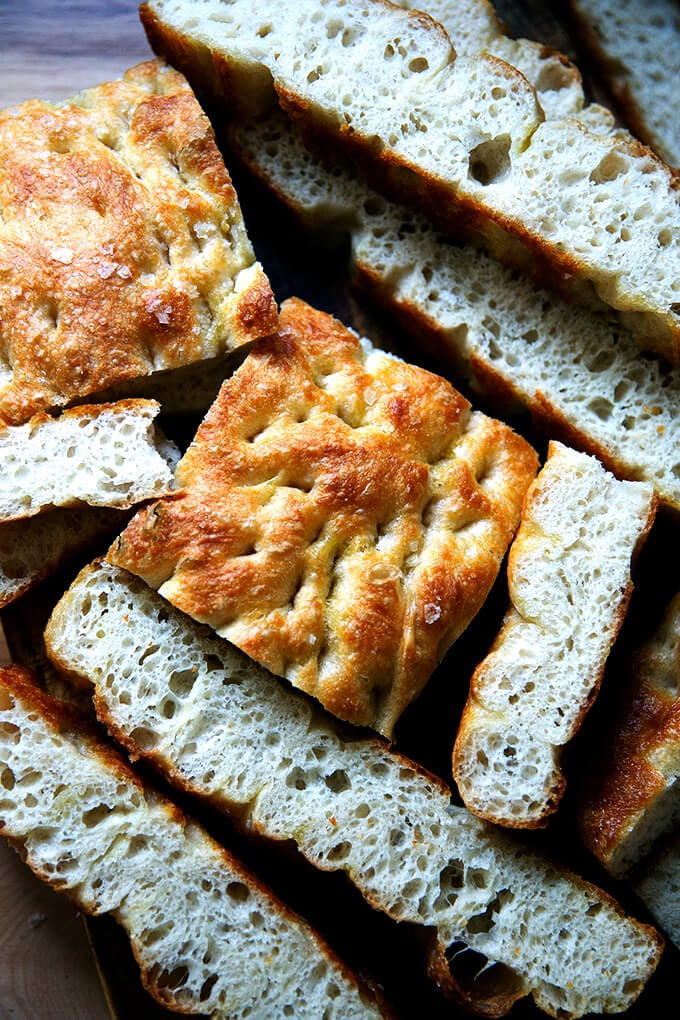
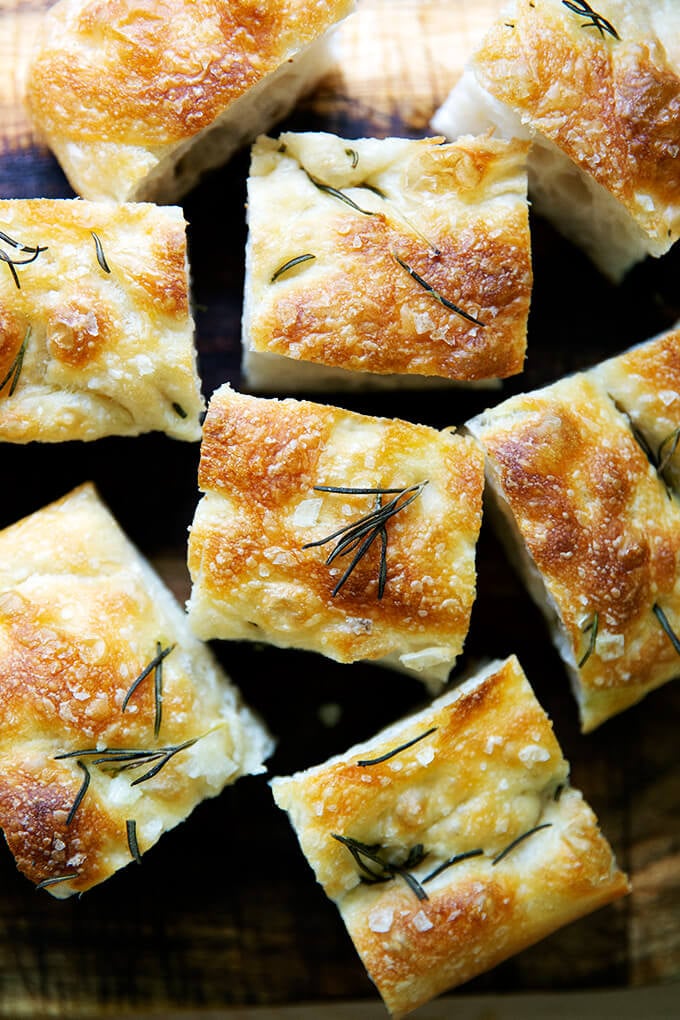
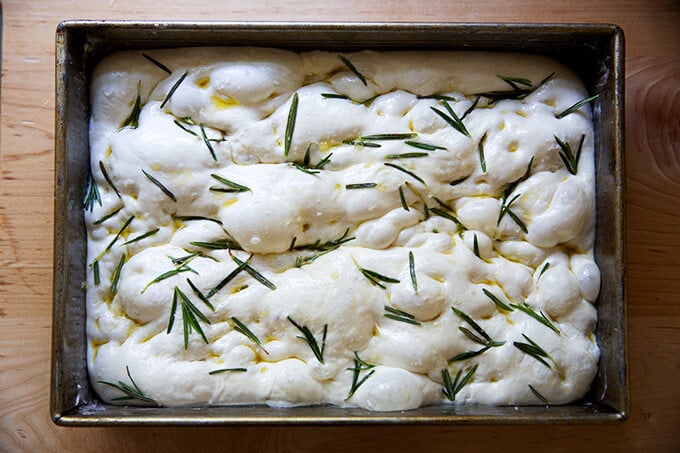
How to Incorporate Rosemary, Herbs, and Other Ingredients & Toppings into Your Focaccia Dough
One of the most frequently asked questions I get is: How can I add other toppings or ingredients to my focaccia bread? You can do this in two ways:
- Add them on top as you would rosemary or other herbs. The key is to make sure the ingredients are slicked lightly with olive oil to ensure they do not burn in the oven. I like to sprinkle the rosemary over top of the dough, then drizzle it with olive oil, then dimple the dough.
- You can add them directly to the dough. In step one, when you whisk together the flour, salt, and instant yeast, add your ingredients — chopped olives, sun-dried tomatoes, roasted garlic — to the flour and toss to coat; then add the water.

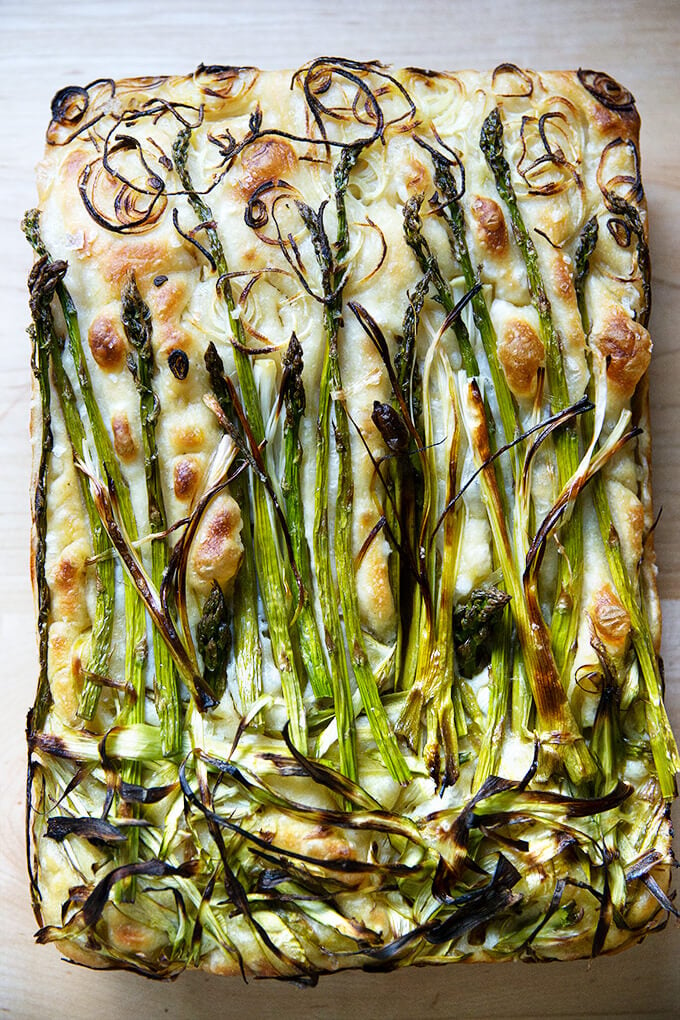
How to Make a Focaccia Bread Art
Pictured above is my “Ode to Spring” (🤣) Focaccia Bread Art (or Garden Scape). As noted above, the key with adding toppings is to slick them lightly with olive oil to ensure they don’t completely char. Keep in mind that some items will char, and a little charring is not a bad thing.
To make a focaccia bread art:
- Follow the recipe through the step in which you dimple the dough just before baking. Arrange your toppings — sliced peppers, asparagus, scallions, olives, tomatoes, onions, etc. — over top and dimple again, pressing the ingredients into the dough to embed them — you can be more aggressive than you think.
- Brush the entire surface with olive oil; then sprinkle with sea salt.
- Bake as directed.
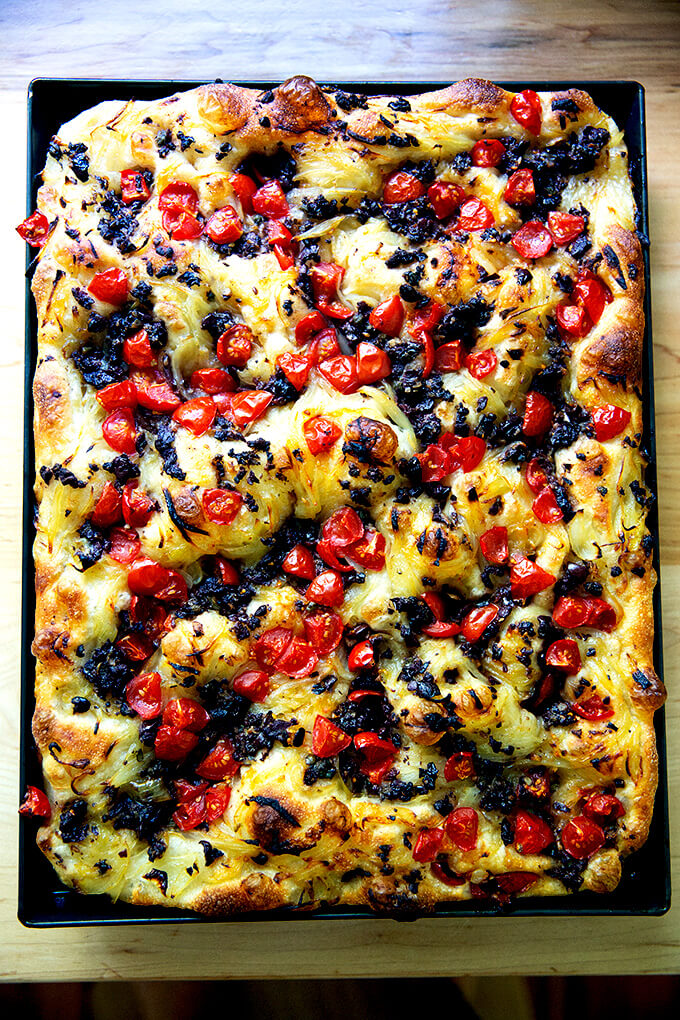
Tomato Focaccia
Pictured above is a cross between pissaladière and tomato focaccia. I love the addition of tomatoes to pissaladière because it adds a freshness and brightness, a hit of acidity to offset the sweet caramelized onions and salty anchovies, olives, and capers.
You can use any summer tomatoes you have on hand — diced cherry tomatoes, Roma, plum, sliced beefsteak tomatoes, heirloom tomatoes, etc. If you choose to dice up Roma or plum tomatoes, there is no need to seed them, but leave any juices lingering on the cutting board behind.
Top the unbaked focaccia with a thin layer of tomatoes; then bake as directed.
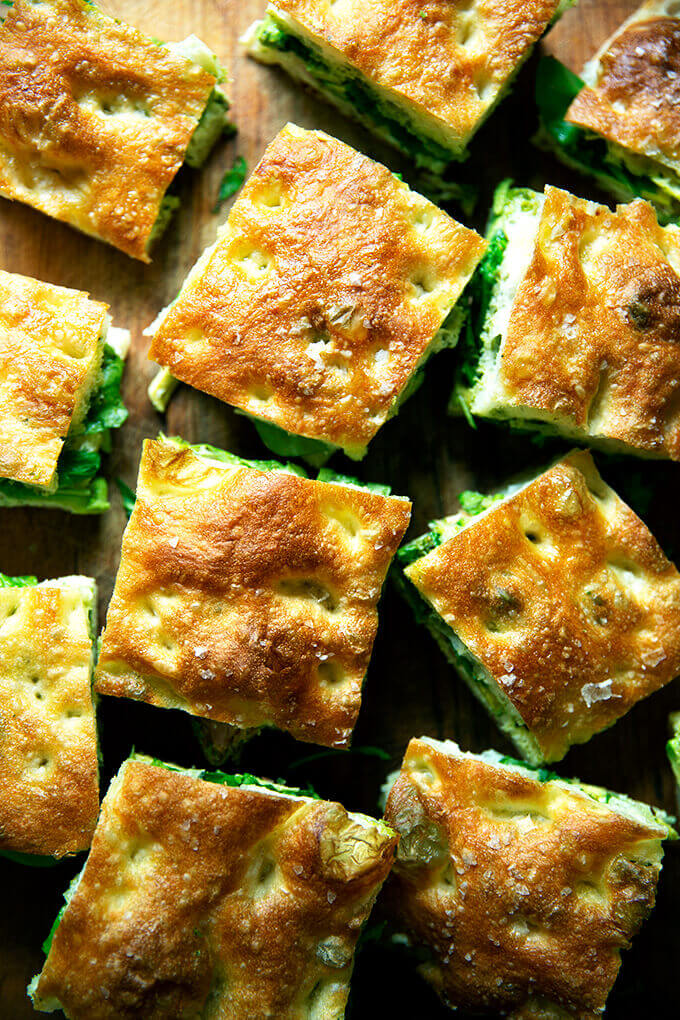
How to Make Focaccia Bread Sandwiches
One of my favorite things to do with either the rounds of focaccia or the 9×13-inch slab of focaccia is to make a giant sandwich: simply halve the whole finished loaf of focaccia in half crosswise; fill it as you wish, close the sandwich; then slice and serve.
Here’s one of my favorites: Roasted Red Peppers, Olive Tapenade, & Whipped Honey Goat Cheese
Can I Make this Overnight Focaccia Without the Overnight Rise?
Yes, you can. In fact, in my cookbook, Bread Toast Crumbs, I do not employ an overnight rise. Start-to-finish it can be made in about three hours. The finished bread will not be as pillowy, but it will still be light, airy, and delicious.
To skip the overnight rise, simply let the mixed dough rise at room temperature until doubled, about 1.5 to 2 hours. Then proceed with the recipe, knowing the second rise will only take about 30 minutes.
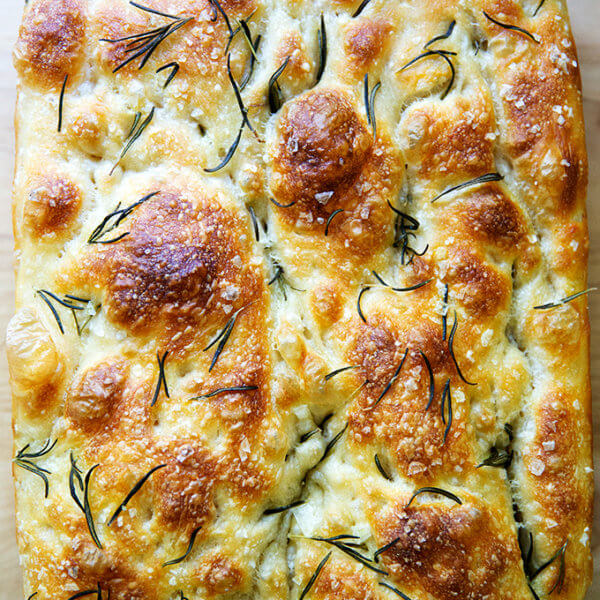
The Best, Easiest Focaccia Bread Recipe
- Total Time: 18 hours 30 minutes
- Yield: 2 loaves
Description
Cold, refrigerated dough is the secret to making delicious focaccia! Allowing the dough to rest 18 to 24 hours in the fridge will yield extra-pillowy and airy focaccia, though if you are pressed for time, you can make this start-to-finish in 3 hours. This 4-ingredient recipe requires only 5 minutes of hands-on time. Video guidance below!
Adapted from the focaccia recipe in Bread Toast Crumbs.
A few notes:
- Plan ahead: While you certainly could make this more quickly, it turns out especially well if you mix the dough the day before you plan on baking it. The second rise, too, takes 2 to 4 hours.
- If you are short on time and need to make the focaccia tonight: Let the mixed dough rise at room temperature until doubled, about 1.5 to 2 hours. Then proceed with the recipe, knowing the second rise will only take about 30 minutes.
- You can use various pans to make this focaccia such as: two 9-inch Pyrex pie plates. (Use butter + oil to prevent sticking.) One 9×13-inch pan, such as this USA pan — do not split the dough in half, if you use this option, which will create a thicker focaccia . A 13×18-inch rimmed sheet pan — this creates a thinner focaccia, which is great for slab sandwiches.
- As always, for best results, use a digital scale to measure the flour and water.
- I love SAF instant yeast. I buy it in bulk, transfer it to a quart storage container, and store it in my fridge for months. You can store it in the freezer also.
- If you are using active-dry yeast, simply sprinkle the yeast over the lukewarm water and let it stand for 15 minutes or until it gets foamy; then proceed with the recipe.
- Flour: You can use all-purpose or bread flour here with great results. If you live in a humid environment, I would suggest using bread flour. If you are in Canada or the UK, also consider using bread flour or consider holding back some of the water. Reference the video for how the texture of the bread should look; then add water back as needed.
Ingredients
- 4 cups (512 g) all-purpose flour or bread flour, see notes above
- 2 teaspoons (10 g) kosher salt
- 2 teaspoons (8 g) instant yeast, see notes above if using active dry
- 2 cups (455 g) lukewarm water, made by combining 1/2 cup boiling water with 1 1/2 cups cold water
- butter for greasing
- 4 tablespoons olive oil, divided
- flaky sea salt, such as Maldon
- 1 to 2 teaspoons whole rosemary leaves, optional
Instructions
- Make the dough: In a large bowl, whisk together the flour, salt, and instant yeast. Add the water. Using a rubber spatula, mix until the liquid is absorbed and the ingredients form a sticky dough ball. Rub the surface of the dough lightly with olive oil. Cover the bowl with a damp tea towel, cloth bowl cover, or plastic wrap and place in the refrigerator immediately for at least 12 hours or for as long as three days. (See notes above if you need to skip the overnight rise for time purposes.) NOTE: It is important the dough really be slicked with olive oil especially if you are using a cloth bowl cover or tea towel as opposed to plastic wrap or a hard lid. If you are using a tea towel, consider securing it with a rubber band to make a more airtight cover. If you do not slick the dough with enough oil, you risk the dough drying out and forming a crust over the top layer.
- Line two 8- or 9-inch pie plates or a 9×13-inch pan (see notes above) with parchment paper or grease with butter or coat with nonstick cooking spray. (Note: This greasing step may seem excessive, but with some pans, it is imperative to do so to prevent sticking. With my USA pans, I can get away with olive oil alone; with my glass baking dishes, butter is a must.)
- Pour a tablespoon of oil into the center of each pan or 2 tablespoons of oil if using the 9×13-inch pan. Using two forks, deflate the dough by releasing it from the sides of the bowl and pulling it toward the center. Rotate the bowl in quarter turns as you deflate, turning the mass into a rough ball. Use the forks to split the dough into two equal pieces (or do not split if using the 9×13-inch pan). Place one piece into one of the prepared pans. Roll the dough ball in the oil to coat it all over, forming a rough ball. Repeat with the remaining piece. Let the dough balls rest for 3 to 4 hours depending on the temperature of your kitchen (Note: no need to cover for this room temperature rise).
- Set a rack in the middle of the oven and preheat it to 425°F. If using the rosemary, sprinkle it over the dough. Pour a tablespoon of oil over each round of dough (or two tablespoons if using a 9×13-inch pan). Rub your hands lightly in the oil to coat, then, using all of your fingers, press straight down to create deep dimples. If necessary, gently stretch the dough as you dimple to allow the dough to fill the pan. Sprinkle with flaky sea salt all over.
- Transfer the pans or pan to the oven and bake for 25 to 30 minutes, until the underside is golden and crisp. Remove the pans or pan from the oven and transfer the focaccia to a cooling rack. Let it cool for 10 minutes before cutting and serving; let it cool completely if you are halving it with the intention of making a sandwich.
- Prep Time: 18 hours
- Cook Time: 30 minutes
- Category: Bread
- Method: Oven
- Cuisine: Italian
This post may contain affiliate links. Please read my disclosure policy.











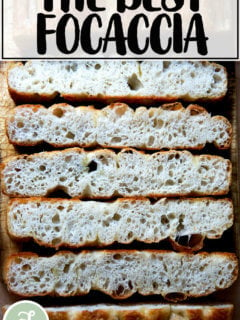


4,139 Comments on “Overnight, Refrigerator Focaccia = The Best Focaccia Bread Recipe”
What kind of whole grain flour could be used, to make this a healthier bread?
Hi Barbarba,
So, the thing about whole grain flour or at least most of the whole grain flour found at most grocery stores is that it’s not necessarily more nutritious. I’ve been reading a little bit about flour, and from what I understand, “whole wheat” flour is processed the same way as all-purpose flour, which is that it’s separated by a roller mill into its three parts — the germ, bran, and endosperm — and then recombined however the company wishes. I think most of the bran is left out, and the germ and the endosperm are combined to create whole wheat flour. Many people believe that as soon as the wheat kernel is separated into its various parts, nearly all of the nutritional value is lost.
So, all of this is to say, a better flour to look for is one that is stone milled, which keeps the kernel intact during the milling process. Some stone mills offer “high-extraction” flour, which has been sifted after milling to remove some of the bran and germ. These flours are generally considered to be more nutritious. I’ve been buying Farmer Ground Flour and using it for about half the amount of flour in my breads (not in this focaccia yet), and I find it works well without making the bread too dense, and it adds some nice flavor, too. Whatever you decided to buy, I suggest starting with 25% or 50% of the whole grain/stone milled flour to ensure your loaves are not too dense. Where do you live? I might be able to find a source of local stone milled flour.
Do you recommend increasing the liquid when substituting whole wheat flour, specifically for this recipe? Thanks!
Hi Sara! It’s so hard to say. Not all whole wheat flours behave the same. I would reference the video in terms of how the dough should look. You might want to hold some back; then add it in as necessary to achieve the right texture and possibly add more, though I would imagine the amount in this recipe is enough — it’s very high hydration.
Made this with half whole wheat flour with great success!…But can’t wait to try the fully AP flour version 🙂
Woohoo!
Your peasant bread and another focaccia recipe are my favorites right now, but I am going to try your focaccia today/tomorrow. What has been your experience in how well the focaccia holds up after baking; ie, is it still tender a day or two later (assuming it lasts that long)?
So happy to hear this, Ann! I find the focaccia in particular is best served the day it is made. If you make it a day in advance, it definitely needs to be heated in the oven for 15 minutes or so to bring it back to life. You can also definitely bake off one round of dough and stick the other one in the fridge for another day. Or you can bake both rounds and freeze one immediately upon cooling. The frozen bread once thawed will also need to be reheated before serving. Hope that helps!
The focaccia turned out to be excellent! I used half of one for the slab sandwich (with grilled chicken breast, etc) and the rest is in the freezer. Very easy, very flavorful with a nice soft-crisp top and bottom which makes it nice for sandwiches. This is definitely a keeper! TY!
So happy to hear this, Ann! The slab sandwiches are fun, right? I’m dreaming up other combinations.
Hi your recipe is the best and use it always when making focaccia. I am wondering can I mix apf and 00 flour to make this? Thank you
Hi Mira! Yes, definitely. You may want to slightly reduce the amount of water you are using… try holding back 50 grams or so.
Yay! Can’t wait to try this thank you!
Woohoo 🙂 🙂 🙂 !!
Hi. Can’t seem to Pin this. I’ve tried different devices and different ways and keep getting a message that there is no image for pinning Can you check it?
Hi Amy! If you hover the mouse over the image, does a red “P” appear in the upper left corner of the image? Let me know if not.
Can you use bread flour?
Yes!
Hello, I’ve been looking for an easy slow rising focaccia recipe and I’m excited about trying this! I’ve put a bowl of dough in the fridge this morning, to bake tomorrow.
I noticed that compared to some other focaccia recipes you have less olive oil. Quite a few of the recipes I’ve seen have much more, the one I was using before had 140ml for the same weight of flour.
Is the lesser amount of oil in your recipe a matter of taste, or would increasing the oil affect the rise/bake of this focaccia?
Thanks!
Yay! I’m excited to hear what you think. Yeah, you’re right — lots of focaccia recipes have olive oil in the actual dough. I suppose I’ve just kept it minimal because 2 tablespoons of oil per each round of dough seems to be enough, but you could definitely add more without affecting the rise times and baking times. Go for it!
Great, thanks so much for your reply!
I will try it as written this time and see how it works for me. This is my first time trying a no-knead bread recipe as well, so very excited about that.
Reporting back, baked my focaccias for lunch today and the results were delicious! Perfect to go with minestrone soup. You were right, it didn’t feel like it really needed more oil, maybe because there’s more flavour in the bread itself compared to quick versions.
This no-knead method is a total revelation. Looking forward to trying out different toppings and maybe I’ll make it a big sheet pan version next time.
Thanks so much for the recipe!
Hi, I accidentally only added one tablespoon of oil for both rounds, how will this affect the foccacia?
Should be fine! Just perhaps a little less brown, but the taste will still be great!
I absolutely love this recipe!! I usually leave it in the fridge for 48 hours before baking. I am asked to make this for every single family get-together we have and have never seen something disappear so quickly!!
So nice to read this, Kat 🙂 🙂 🙂 Thanks for writing!
I had stracchino cheese focaccia in Riomaggiore last fall and I’ve been dying for it since. How would I make that with your recipe? (Not that I can find stracchino)
Hi Karen! Did it look like this: https://food52.com/blog/12384-focaccia-di-recco ? As in, was it a cheese-filled focaccia? That sounds amazing, and if so, I would probably divide this dough into 4 pieces (after the first rise), let the rounds rise for about an hour, stretch them, top two of the rounds with cheese, top each cheese-topped round with a round of dough, press to seal, then let it rise again for another few hours. If the dough was simply topped with cheese, I would add it when you dimple the dough, right before you stick it in the oven. Let me know if you find stracchino!
Thanks. Yes, I think it was cheese filled. Will it be hard to work with and stretch thin? I was thinking of using burrata instead of straccio. I’ll let you know how it turns out
burrata sounds delicious! I wouldn’t try stretching this dough so thin … don’t think it’s the right makeup for that. But I think you could still make it delicious by incorporating the cheese on top or layered as described earlier. Good luck!
Oh Ali, this brought back an amazing food memory! Approximately one gizillion years ago (20 years) I worked in the Mission district, way before it was a food Mecca. There was (briefly) a coffee shop next to my office called thé, and every morning walking into the building the most amazing scent of fresh bread and pastry would come wafting through the air, it was the best reason to come to work every day! My favorite treat there was their breakfast focaccia with roasted red grapes, rosemary and Demerara sugar. It was so delicious just the right blend of sweetness and salt. Your recipe and pictures made this come back so vividly! This is absolutely on the menu this weekend!
ELLEN!! It has been toooo long. That breakfast focaccia sounds amazing. I have two more batches of this focaccia in the fridge … thinking one might have to get that treatment. Hope you are well!
Can you give some instruction for roasting the grapes for that? Sounds amazing. Grapes are pretty juicy, so how do you keep it from making the bread soggy in spots? The roasting would take a little out. Or do you roast for quite a long time?
Ellen — please chime in! Lavonne, I’ve actually used uncooked grapes on focaccia, and those are also delicious. BUT, if you want to stick to Ellen’s vision, which sounds completely amazing, you could follow the instructions on this post for roasting: thyme roasted grapes. I would leave most of the liquid behind, though it might be nice drizzled over the dough?
*If* I remember correctly the grapes were halved, and scattered cut side up, so that the edges of the grapes and the juices could caramelize a bit. Then the whole thing was sprinkled lightly with rosemary. Hope you love it too, Lavonne!
it sounds so darn good
Thank you both! Can’t wait to try it.
Hi Alexandra! How does this compare to your focaccia with the Jim Lahey dough (which is TRULY addictive!)? Thanks!
https://alexandracooks.com/2013/06/12/pissaladierefocaccia-what-to-do-with-past-prime-lahey-pizza-dough/
Very similar! I think the biggest revelation I had with these recent focaccia experiments is: less is more. I literally don’t touch the dough after I get it shaped and into the pie plates for 2 to 4 hours, and then it’s one dimple and into the oven. In the past, I’ve stretched and let it rest, dimpled and let it rest, dimpled some more, etc. If I were to make the Lahey focaccia again, I would try the same technique to see if I could get those dimples to stay. BUT I’m so glad you like the Lahey focaccia, and I’m also all about: if it ain’t broke, don’t fix it 🙂 Keep on making what you like. xoxo
I have been waiting for this beautiful recipe! With two small kids running around you are aninspiration for me to attempt a recipe like this (I too have small monsters underfoot). Thank you!
Yay!! Chelsey, I hope you love it!! xo
Hi Ali – have you tried it withC4C?
If no, what recipe modifications would you suggest, if any?
My dream is gf focaccia (now that you’ve mastered gf peasant bread! : )))
Hi Kathleen! I have not tried this with gf flour yet. I would probably keep the recipe the same as for the peasant bread, but use two shallow vessels, like pie plates (buttered first, then drizzled with olive oil), and after the initial (and only) rise, I would dimple it gently before sticking it in the oven. I don’t think refrigeration does anything for gluten-free breads because there’s no gluten development, but I could be wrong. Hope you are well!
Hello Ali
Excited to try the recipe! Can I make it in larger versions, perhaps baking on half sheet pans??
Thank you,
Karla
Yes, absolutely! No need to divide the dough if you want to use a single sheet pan. Same rise times and bake times will apply.
I’ve been trying to learn a bit about sourdough breads and wondered if there’s a way to adapt a yeast recipe to use sourdough starter instead, or if it would need to be a whole new method, ingredients, etc. Thinking a sourdough focaccia would be very nice.
Sourdough focaccia would be so nice! I can give you my proportions for what I do with the peasant bread recipe when I use a sourdough starter, which should offer some guidance:
50 g starter
2 cups (430 g) lukewarm water
2 tsp. kosher salt (10 g)
4 cups (512 g) all-purpose flour
The first rise can take all day, so often at the end of the day, I divide the dough, place the portions in buttered pyrex bowls, and stick them in the fridge. In the morning I take them out, and let them rise for about 2 to 4 hours before baking them off. Hope this helps!
Hi! This is going to be my first attempt at making bread! It looks easy enough for me to start with this. This may sound stupid since I am new at this but what is the best cover to use since I don’t have one like yours! Love your blog and watching you cook❤️
Hi Sally! Thanks so much for the kind words 🙂 I would just use a tea towel. If you dampen in with warm water, it will stay in place, but it’s not necessary. Before I used the cloth bowl covers, I used tea towels and would secure them with large rubber bands. They also sell plastic bowl covers that look like shower caps at the grocery store. Those work too and you can reuse them .
This is in the oven as I type!!! My daughter and I are focaccia fanatics! I have a feeling, since it’s your recipe, it will be awesome!!!
Yay!! Can’t wait to hear how they turn out!!
Turned out perfectly!!!!! My 10 year old’s comment “This is soooooo good…I want another slice!!!”
Yay!!!!!!! Makes me happy, Rosa 🙂 🙂 🙂
How hot and how long to reheat after thawing? Does it need salt reapplied?
350ºF for 15-20 minutes or until crisped and golden and revived 🙂 No need to reapply salt.
I made this today, the loaves came out looking and tasting great, but they stuck to the bottom of the pans, a significant amount of the bottom crust was lost. I have made focaccia with peasant bread dough in a 13 by 9 by 2 inch pyrex pan and never had it stick, but I have buttered the pan in addition to olive oil. I used 2 pyrex pie dishes and plenty of olive oil, not sure what the problem was.
Oh Amy, I’m sorry to hear this! So, did you not butter the pyrex pie plates this time? I have found it to be essential to either use parchment paper or to butter the pans before adding the olive oil to prevent sticking. The type of pan makes a difference, but I’ve gotten in the habit of buttering prior to adding the oil no matter the type of pan I am using because the oil alone does not prevent sticking. So bummed to heat that part of the crust was lost.
Thanks for your reply, I did not use butter, was just depending on the oil. The next time I will also butter the pans. My peasant bread never sticks in the pyrex bowls as I always use butter. The bread still tasted great and we made sandwiches with fresh mozzarella and prosciutto
So happy it wasn’t completely ruined. I don’t know why butter is such a better nonstick barrier than oil, but I’ve learned the hard way, too. Again, some pans work fine, but it’s hard to know which pans work until you give them a go.
I made this again today, this time using butter on the same pyrex pie pans and there was no sticking!
It is now my family’s favorite bread for sandwiches. Thank you.
Hello Alexandra,
I discovered your blog a few weeks ago, when you posted the crackers recipe. I tried right away and they were a hit. Thanks a lot! I looked into your book then, curious about your mother’s peasant bread recipe. I began baking my own bread years ago with the Jim Lahey no knead method. I then discovered the magic of baking with sourdough starters and since then, I’m always trying new recipes and methods for all kind of breads. Thanks for inspiring us with plenty of options that always turn out great I tried the quinoa/flaxseed bread, the walnut bread and just today for lunch, the foccacia. I didn’t have time to take a pic to post on my Instagram because we ate everything. Right out of the oven as a slab sandwich, it was delicious!
This long comment just to let you know I’m very happy I “bumped into your blog” (not sure I can write that but I’m French so you’ll excuse me 😉 and to thank you for all your sharings. Have a nice Sunday.
Caroline, thank you for your sweet, sweet comment. Your English is perfect 🙂 I love Jim Lahey’s bread and I love attempting sourdough, too, but most often I’m making some variation of my mother’s peasant bread. I’m so happy the crackers were a hit, and I’m so happy you wrote. Where in France are you? My husband and I are trying to figure out how we could spend a month there this summer … it’s fun to dream at least.
Thanks for your answer Alexandra! I’m French, my husband is French as well but we are living in the USA since 18 years. We spent 3 years in Boston when we arrived and we’ve been living in St Louis (Missouri) for 15 years now. It’s not exactly the city of my dreams but it’s a great place to raise kids. We go back to France every 2 years, and we have family and friends almost all over France so do not hesitate if you need any information. I would be happy to help if I can.
Hello Alexandra,
I discovered your blog a few weeks ago, when you posted the crackers recipe. I tried right away and they were a hit. Thanks a lot! I looked into your book then, curious about your mother’s peasant bread recipe. I began baking my own bread years ago with the Jim Lahey no knead method. I then discovered the magic of baking with sourdough starters and since then, I have always been trying new recipes and methods for all kind of breads. Thanks for inspiring us with plenty of simple options that always turn out great. I tried the quinoa/flaxseed bread, the walnut bread and just today for lunch, the foccacia. I didn’t have time to take a pic to post on my Instagram because we ate everything. Right out of the oven as a slab sandwich, it was delicious!
This long comment just to let you know I’m very happy I “bumped into your blog” and to thank you for all your sharings. Have a nice Sunday.
Wow, this is now my favorite focaccia recipe, I just tasted it, it’s phenomenal. I used bread flour and in addition to salt I topped it with garlic and oregano. Thank you so much. Is there a way I can upload a photo to you?
So awesome to hear this, Dolly! Email me the photo: ali.c.stafford@gmail.com I’d love to see it!
I currently have these beautiful focaccia in the oven! The aroma is devine! I am using them to make steak sandwiches with an arugula pesto and oven roasted tomatoes. In regards to the the previous post about the roasted grapes and rosemary I have made a focaccia with red grapes, Brie and Rosemary. The grapes do not need to be pre-roasted. Just make sure you press them into the dough so they don’t roll off (speaking from experience!) This combination is always a hit!!
Yay Leigh!! Can’t wait to hear how it turns out. The combination sounds absolutely divine! Enjoy your dinner 🙂
They turned out perfectly! My husband and son claimed it made top 5???????? Thanks for the recipe! I’ve enjoyed your blog and Instagram for several months now. I always look forward to what’s next!
Yay! So happy to hear this, Leigh! Means the world. xo
Hi Alexandra,
Since it’s Academy Awards night, I’m giving my award to you for best cooking site on the internet.
I read your recipes and commentary and think, “How does Alexandra know what flavors I love, what I’d like to try next?”. (I just made another batch of preserved Meyer lemons yesterday.)
Thanks for creating such a delicious world.
Deborah, you are too, too kind … thank you!! This means the world, truly. So happy to hear about the preserved lemons. A batch I made about a month ago is nearly there. So nice to have on hand. Thanks for writing in. xo
Could you use an infused olive oil? I have a Tuscan Herb infused olive oil that I thought I might try on one.
Thanks,
Susie
Yes, absolutely!
Your photos are beautiful and inspiring! A question: when removing the dough from the fridge after the overnight rise, do you portion it and place into the baking dishes immediately, then let it rise 2-4 hours, then bake? Or do you allow the dough to come to room temp before portioning it and proceeding? Thank
Thank you Linda! Good question: I portion it immediately, while it is still cold. Then let it rise 2-4 hours. Be sure to butter whatever vessel you use before you add the olive oil. This will prevent sticking. Good luck!
I love how easy this focaccia is to make! I am about to pop them into the oven and I CANNOT wait!
Yay!! Hope they turned out well … can’t wait to hear!
Oh yum! I’ve made focaccia on many occasions, but never has it been so easy. The flavor development from the overnight slow rise is, well, wonderful. Thank you for this! 3 “S’s” for dinner tonight salad, soup, and sandwich. Mmmm
So happy to hear this, Peggy! I could live on the three s’s 🙂 🙂 🙂
I made this last weekend and an planning it again this weekend. It’s so easy and do delicious. We devoured it in about 10 minutes!
Yay!! So happy to hear this, Jamie.
Just made my 1st 2 loaves! While they are still delicious, I completely lost the big beautiful second rise (did almost 5 hours) as soon as I punched in the dimples. It completely deflated. The loaves are totally flat, not deep enough to make a sandwich easily. What do you recommend I do next time? Not press down as hard? Thanks!
OK- so I just rewatched your IG video and I think I know the problem. After the first rise, I immediately divided the dough and took it out of the big bowl (forgetting to deflate it). Then the dough rose super high on the 2nd rise, so when I dimpled it, it was the first time it had really been deflated. Do you think that was the issue?
Oh, bummer! I don’t think you did anything wrong my not deflating it immediately — when you divide it into two portions, you essentially deflate. I think you probably let the second rise go too long. The last time I made it, I let it rise 4 hours, and when I dimpled it, I could tell the dough was a little fragile. I got lucky, and it worked, but I think 2 to 3 hours for a second rise is ideal. When you dimple it, you should definitely feel some air being lost, but you should also almost be able to feel you are creating tension and therefore more pockets for the air to expand and create that nice texture you are looking for. There’s definitely a sweet spot in terms of that second rise. Next time, I would just let it rise 2 to 3 hours, dimple it, and get it in the oven. Hope that helps!
Alex, for the grape focaccia would you press the grapes in the dough prior to the 2-4 hr rising or wait until going into oven and press in? I have made grape focaccia before but not using this fridge technique. I press them in rested dough after it is stretched into the pan and then it rises again with the grapes. So I am a bit unsure which way to go with your no-knead fridge method. I will be making one larger focaccia in a sheet pan.
Hi Deni,
I would wait to press them into the dough until you dimple it — so, after 2 to 3 hours, drizzle the olive oil over the dough, scatter the grapes (and any other toppings) over top, dimple straight down, sprinkle with sea salt, and immediately transfer to the oven. Hope it turns out well! Looking forward to hearing about.
This recipe looks amazing. Could I make the dough and bake half according the recipe and then save the other half to bake the next night? Or should I bake them both at once and then reheat the second one?
Thanks!
Thanks alex, I added the grapes after 4 hours at room temp as suggested but let it sit 30 min so that the grapes were contained a bit. The grapes kind of take the place of the dimples! Nice fluffy results, thanks for this method.